![]()
The Tradition, Book One
![]()
by Rev. Chung Hwan Kwak
|
|
The Tradition, Book One |
|
|
|
by Rev. Chung Hwan Kwak |
[Page 150]
Chapter 18
Holy Robes
History
A spiritual medium received in a vision that Holy Robes were the customary dress in the Kingdom of Heaven. Therefore, the first Holy Robes were made according to the specific style received in this vision.
For several special prayer ceremonies, white robes were used before the 36 Couple Blessing.
The couples blessed in the 36, 72, and 124 Couple Blessings wore Holy Robes.
Significance
The Holy Robes (referred to as Yae Bok) are formal ceremonial clothes and they symbolically purify us externally. Blessed members should cultivate a more holy feeling and attitude when wearing these special robes.
Standard of Holy Robes
As there are many occasions on which blessed couples should wear their Holy Robes, all couples should obtain their own Holy Robes.
The term "Holy Robe" refers to the robe itself as well as to the Korean-style garments worn underneath.
Robes
Holy Robes should be made according to a standard pattern (refer to diagrams 18.1 and 18.2) and be made of pure white cloth with white decoration. A belt of the same white cloth should also be worn
[Page 151]
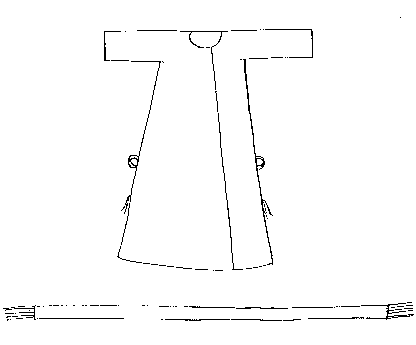
Figure 18-1
18.1. Holy Robe
18.2. Belt
on the outer robe; it can be decorated with simulated pearls, a fringe, or small beads. The beads can be either white or another color (for example, green or yellow for men, and pink for women). No exact number of beads has been set; however, if it is possible, it would be best to use a providentially significant number of beads.
Color and Material
All garments, including undergarments and socks, should be white.
Many types of material, with either a shiny or matte finish, are appropriate for making Holy Robes. The material may be either heavy or light depending on the weight of the material of the Korean-style or alternate garments to be worn underneath. There can be a subtle pattern on the material such as flowers, cranes, etc.
[Page 152]
Korean-style Garments
Korean-style garments (see diagrams 18.3 and 18.4) for both men and women represent the worldwide standard of clothing to be worn underneath the Holy Robes: for women, a chima choguri, for men, ba ji jogori (pants which tie at the ankles, a jacket, and a vest). In addition, men may choose to wear an inner white Korean robe (diagram 18.5) only on very formal occasions.
Alternate Clothing. If it is impossible to obtain the Korean-style garments, men should wear a white shirt, pants, belt, tie, and socks. Women may wear their wedding dress (Western) or, if possible, a full length, all-white dress.
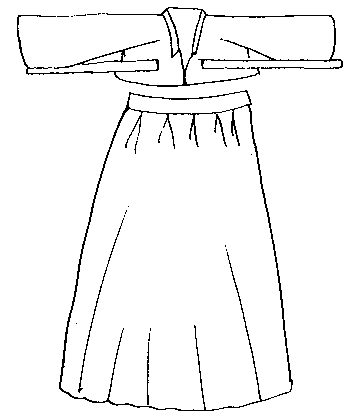
Figure 18-3
18.3. Chima choguti, for women
Gloves
White gloves are to be worn in use with the Holy Robes at Holy Day celebration services, Blessings, Seung Hwa Ceremonies, and, if possible, for the Three and Eight Day Ceremonies, as well as for special Pledge services.
[Page 153]
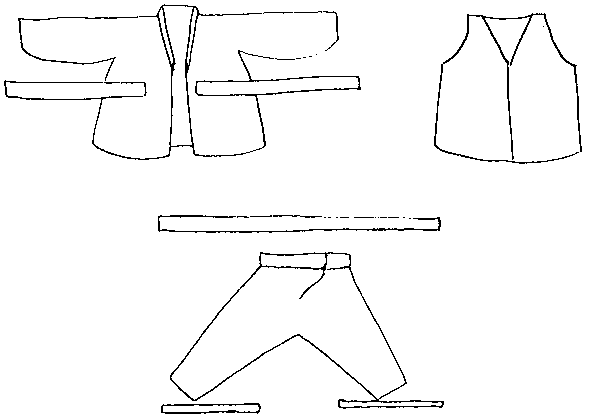
Figure 18-4
18.4 Ba ji jogori, for men
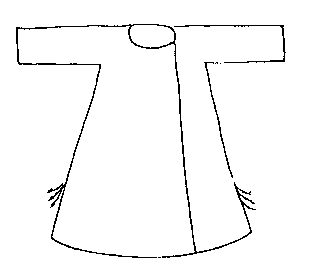
Figure 18-3
18.5. Inner white Korean robe
[Page 154]
Undergarments Worn with Holy Robes
All undergarments including socks must be white.
It is not necessary for blessed members to purchase special under- garments to be used exclusively for the occasions on which they wear their Holy Robes.
Lost or Stolen Clothing. If a member's clothing (e.g., undergarments, gloves, socks) is lost or stolen, the item(s) should simply be replaced.
Wearing Holy Robes
Diagrams 18.6 to 18.9 indicate how to tie the sashes on the Korean style garments.
Occasions to Wear Holy Robes
Holy Day Celebration Service
On Holy Days, blessed members may wear Holy Robes. Blessed members should definitely use the robes if they are attending a main Holy Day Celebration service with True Parents or their representatives. However, if desired, blessed members may wear Holy Robes during any Holy Day celebration prayer service (local level, state level, or national level), especially if blessed members gather for a special blessed members' Pledge service.
Each item of clothing worn on such occasions must be completely white. It is not permissible on this occasion for a man to wear his Blessing suit under his Holy Robe. If he does not have the Korean style clothing, he should obtain and wear items listed under Alternate Clothing, this chapter.
Three Day Ceremony
The Holy Robes (and Korean-style garments) are traditionally worn for the Three Day Ceremony (or the ceremony to begin married life).
Eight Day Dedication Ceremony
The robes are traditionally worn for the Eight Day Dedication Ceremony of each new child.
[Page 155]
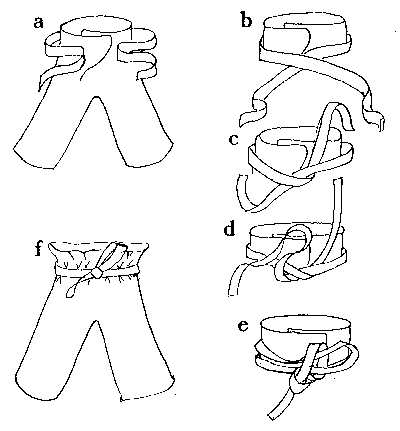
Figure 18-6
18.6. How to tie the belt of the ba ji jogori

Figure 18-7
18 7. How to tie the ankle sashes of the ba ji jogori
[Page 156]
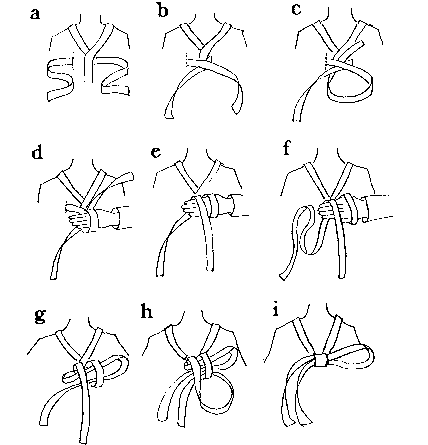
Figure 18-8
18.8. How to tie the sash of the chima choguri
40-Day and 100-Day Celebrations
Holy Robes may be worn if parents choose to hold either a 40 or 100 day celebration (both are optional) for their child.
Pledge Service
Blessed members may choose to use their Holy Robes during any Pledge services, but this is optional.
[Page 157]
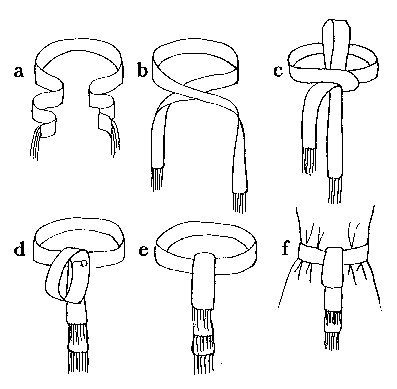
Figure 18-9
18.9. How to tie the belt of the Holy Robe
All blessed members may wear Holy Robes to Pledge service. Engaged couples, however, should wait until after the Blessing ceremony before participating in this tradition.
Special Celebration with True Parents
If a blessed member is invited to a special celebration with True Parents or the True Family, such as a Blessing of the True Children, it may be appropriate to wear Holy Robes.
Seung Hwa Ceremony and Burial
Blessed members will be buried in their Holy Robes.
[Page 158]
Care of Holy Robes
Each couple will use the Holy Robes (including the Korean-style garments) on numerous occasions throughout their lives; therefore, these garments should be kept carefully and should be cleaned if they become soiled.
Borrowing Holy Robes
If blessed members are invited to attend a Holy Day celebration service (i.e., with True Parents or their representatives) and did not bring their Holy Robes, it is permissible to borrow another blessed member's Holy Robes and white clothing (whether Korean-style garments or alternate clothing, listed in the previous section).
Receiving or Purchasing New Holy Robes
If a blessed member purchases or is given a new Holy Robe, he or she may keep the old one and use it as an alternate.
Reblessing
In the event of a reblessing, the blessed member will probably want to obtain a new Holy Robe, particularly if the old one was ever worn.
Holy Robes for Blessed Children
As blessed children are constantly growing, there is no specific age at which they should begin to wear Holy Robes. However, one suggestion would be to prepare a Holy Robe for a child who is old enough to appreciate its significance.
Parents may bestow the gift of their Holy Robes (one used as an alternate) to one of their children at such a time.
[Page 159]
Download entire book in ZIP format
Table of Contents
Copyright Information